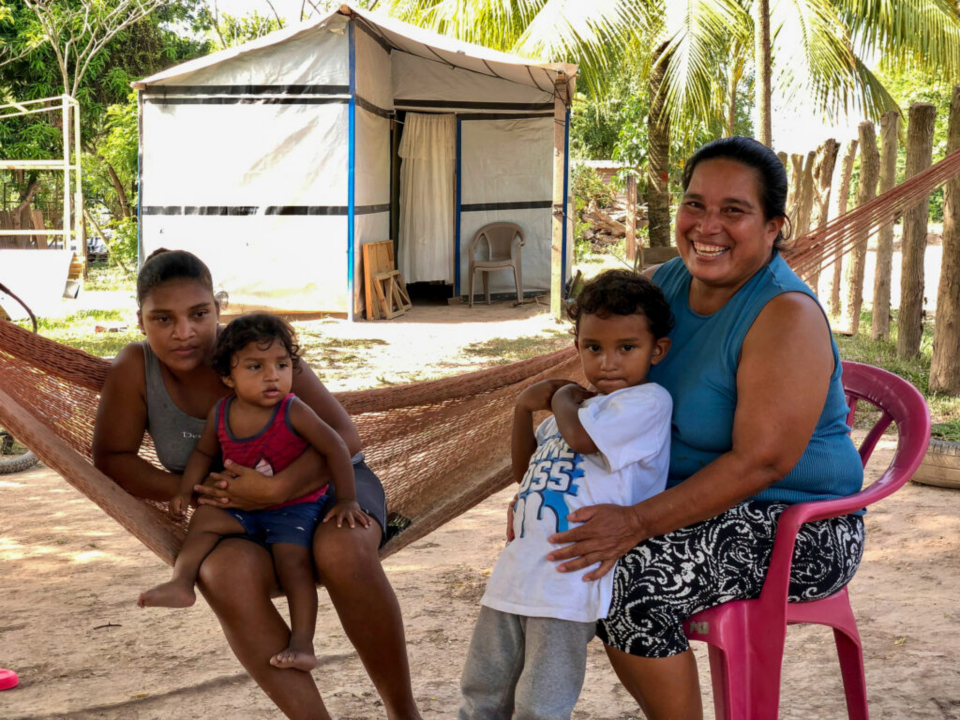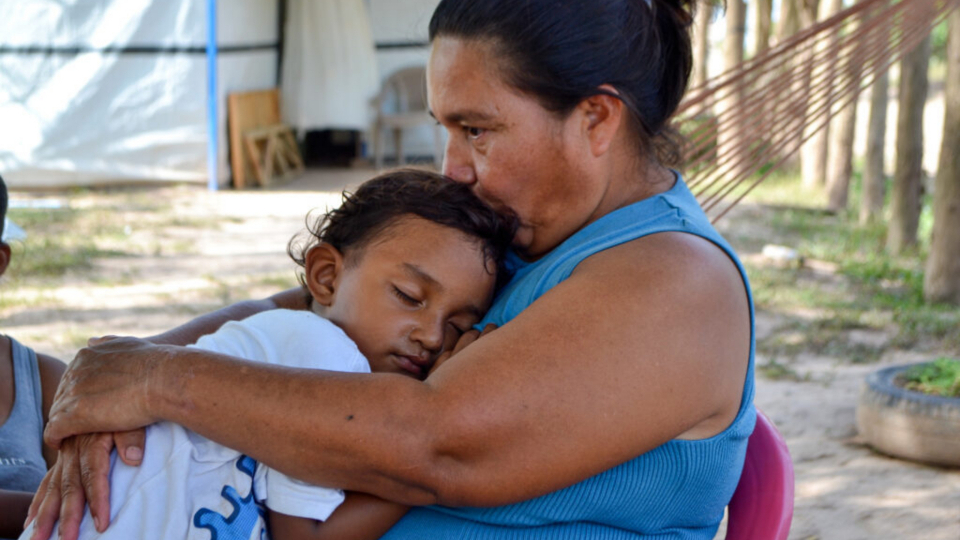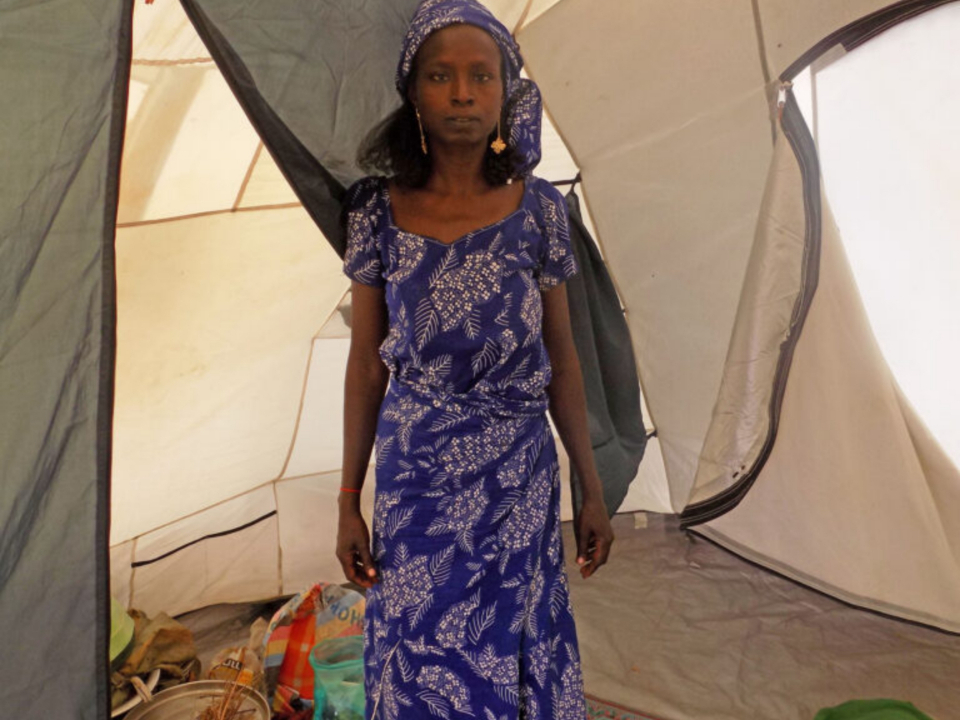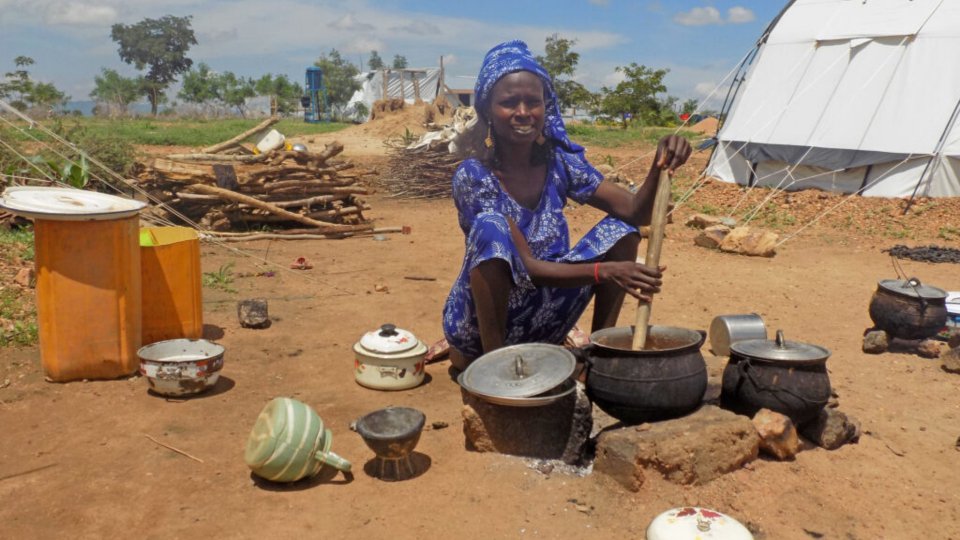
ShelterBox
Maria poses with her children in front of their new shelter after hurricanes destroyed her Honduras town in October and November of 2020. Photo courtesy of ShelterBox, courtesy of Church News.All rights reserved.
This story appears here courtesy of TheChurchNews.com. It is not for use by other media.
By Mary Richards, Church News
The water was getting higher in the town of La Lima in northern Honduras, and Maria and her family knew they had to abandon their house. Hurricanes Eta and Iota had made landfall back to back in October and November 2020. For 15 days, the family had to move from shelter to shelter.
“When I finally returned home, I saw everything was moldy and useless,” said Maria. A nonprofit humanitarian organization called ShelterBox gave her family an emergency kit with essential items like tarps, a kitchen set, solar lights, a water filter, blankets, a mosquito net, and tools to build a shelter — the kinds of things that are needed to set up a household after losing everything.
“The aid we received from ShelterBox helped us rebuild our home after the storm. Everything was handy, but especially the tarpaulin. I used it to cover the corners and walls of the house that had been damaged,” Maria said.
ShelterBox USA president Kerri Murray shared Maria’s story as one of thousands of people they were able to help in Honduras through a partnership with Latter-day Saint Charities. After those hurricanes hit, Honduran families were living in crowded communal shelters. ShelterBox used a donation from Latter-day Saint Charities to make a rapid response to the country. Because of the partnership with Latter-day Saint Charities, 3,208 displaced families received emergency shelter and basic household items, which allowed them to begin recovering from the disaster.

ShelterBox
Maria holds her child in front of their new shelter after hurricanes destroyed her Honduras town in October and November of 2020. Photo courtesy of ShelterBox, courtesy of Church News.All rights reserved.
“We hear from family after family that shelter is the first step in their recovery,” said Murray. Once families can meet their shelter and household needs, they can establish some normalcy in their lives, reestablish communities, get back to work and children can go back to school. They can start to look forward.
War, famine, hurricanes, flooding, earthquakes and other disasters have displaced hundreds of millions of people around the world in recent years. There are more people displaced in our world than in any time in recorded history. Murray said Latter-day Saint Charities began its partnership with ShelterBox, providing grants and donations for shelter projects back in 2017 to support Syrians displaced by the war, as refugees needed help getting back on their feet. And since then, the partnership has helped hundreds of thousands of men, women and children across the world.
Both organizations have been working together in Sudan, Burkina Faso and Cameroon. Murray calls the challenges families face in the Lake Chad Basin of Africa the forgotten crisis. Violence from militant groups has led to mass displacement. Nongoma, a 34-year-old mother of seven children, is one of those families. She was forced to flee her home and her village in Burkina Faso and live in a displacement camp ever since.

ShelterBox
Nongoma has created a new home for her children after being forced to flee her village in Burkina Faso in 2020. Photo courtesy of ShelterBox, courtesy of Church News.All rights reserved.
“There were a few incidents in the neighboring village earlier on in the year, so but we thought we were spared — until the armed groups arrived in our village. It was at the market that they started shooting, and my husband who was there died. We were forced to flee without taking anything with us,” she said.
Like so many refugees, Nongoma was formed to flee with nothing more than the clothes on her back. After arriving at the refugee camp, Nongoma received an emergency shelter and other household supplies, allowing her to create a new home for her children as she began to work on their next steps.
“The help of Latter-day Saint Charities and ShelterBox with the new, beautiful tarpaulins, we are now well-housed, and I am very satisfied,” she said.
Meanwhile Fanne is one of thousands of women who have refugee status in Cameroon. She arrived at the border after fleeing violence from Boko Haram in Nigeria. Her husband had an injury and would follow them.

ShelterBox
Fanne, a young mother who had to flee her home in Nigeria, is pictured inside her ShelterBox tent at a refugee camp in Camarron in 2020. Photo courtesy of ShelterBox, courtesy of Church News.All rights reserved.
“Before getting to the collective center, I did not realize what was happening. I was just worried about running away and being met with a cruel reality. All my possessions were left behind. I had no official documents, no food, no money, no clothes. I had lost everything,” she said.
ShelterBox included Fanne’s story in their report on their efforts helping 3,745 refugees in Cameroon. Fanne and her eight children are living in Minawao Refugee Camp. She received assistance from ShelterBox and Latter-day Saint Charities, including a tent, blankets, solar lamps, bucket, water carriers and more. She is now trying to create a new life.
“I feel safe in my tent, but it is still different from my home. Home is important to anybody because it is the place you have some rest after a stressful day. It is like a refuge, it keeps you safe from rain, sun and wind. My favorite object in possession is my pot that I use to cook. That is the only thing I cannot share; my children eat thanks for it,” she said.

ShelterBox
Fanne said the cooking pots were a big help for her family as they stayed in Minawao Refugee Camp after fleeing violence in Nigeria in 2020. Photo courtesy of ShelterBox, courtesy of Church News.All rights reserved
In emergencies, one can see the best in humanity in the response effort, Murray said. And volunteers from her organization in rapid response teams have been able to reach people in nations where no one else could reach, because of the help of The Church of Jesus Christ of Latter-day Saints.
One example was when Category 5 Cyclone Harold devastated the island nation of Vanuatu in April 2020, just as the world was locking down due to COVID-19. Tens of thousands of families were displaced in the disaster, and borders were closed because of the pandemic adding complexity to responding to the region. Murray shared: “We were unsure if we would be able to have the support to be able to respond in the region, but then we received a call from Latter-day Saint Charities offering their help in Vanuatu. Having the support of Latter-day Saint Charities made all the difference, and we immediately began building our response in the region.“
“For these families, they thought no one was coming for them. We went from island to island on boats. With the support of Latter-day Saint Charities, we were the only aid organizations outside of the South Pacific that were able to respond in Vanuatu. It was lifesaving for these families,” she said.
Now the groups are working together again to help in Haiti after that Caribbean island nation’s earthquake in August, and also working on Winterization Programs in Syria to help families displaced from the civil war. ShelterBox and Latter-day Saint Charities focus on helping the most vulnerable people in the poorest countries, and the demand for their humanitarian relief efforts is only growing.
“I have the most full heart when I think of our partnership with Latter-day Saint Charities,” said Murray. “I feel that the Church is in the DNA of everything we do.”